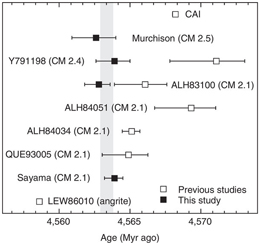Research Abstract
隕石中の年代の若い炭酸塩から得られた含水小惑星が遅く形成された証拠
Evidence for the late formation of hydrous asteroids from young meteoritic carbonates
2012年1月17日 Nature Communications 3 : 627 doi: 10.1038/ncomms1635

太陽系内の小天体の集積は、惑星形成の前段階の重要な過程である。隕石の年代学的情報により、小惑星の形成時期を制約することができる。二次的な炭酸塩は、極めて古い53Mn-53Cr法による放射年代を示しており、含水小惑星の中には急速に集積したものがあることを示唆している。しかしながら、これまでの研究は正確なMn/Cr比を決定することができておらず、このような古い年代が人為的なものである可能性を否定できなかった。本論文では、正確にMn/Cr比を決定する新しい手法を開発し、炭素質コンドライト中の炭酸塩について45億6340+40/-50万年という信頼できる年代を得たことを報告する。これらの炭酸塩は同一の年代を示し、これまで見積もられていたよりも若いことがわかった。この結果は太陽系では水の活動の始まりが遅かったことを示唆している。炭酸塩の若い年代は、小惑星の母天体が太陽系誕生から300万年以内に集積したのでは説明することができない。したがって、含水小惑星は分化した小惑星や熱変成した小惑星よりも後で集積したと結論できる。
- 東京大学大学院理学系研究科 地球惑星科学専攻
- 東京大学 大気海洋研究所
The accretion of small bodies in the Solar System is a fundamental process that was followed by planet formation. Chronological information of meteorites can constrain when asteroids formed. Secondary carbonates show extremely old 53Mn-53Cr radiometric ages, indicating that some hydrous asteroids accreted rapidly. However, previous studies have failed to define accurate Mn/Cr ratios; hence, these old ages could be artefacts. Here we develop a new method for accurate Mn/Cr determination, and report a reliable age of 4,563.4+0.4/−0.5 million years ago for carbonates in carbonaceous chondrites. We find that these carbonates have identical ages, which are younger than those previously estimated. This result suggests the late onset of aqueous activities in the Solar System. The young carbonate age cannot be explained if the parent asteroid accreted within 3 million years after the birth of the Solar System. Thus, we conclude that hydrous asteroids accreted later than differentiated and metamorphosed asteroids.

